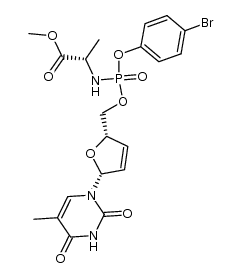Stampidine
Modify Date: 2024-01-10 01:30:57

Stampidine structure
|
Common Name | Stampidine | ||
|---|---|---|---|---|
| CAS Number | 217178-62-6 | Molecular Weight | 544.29000 | |
| Density | N/A | Boiling Point | N/A | |
| Molecular Formula | C20H23BrN3O8P | Melting Point | N/A | |
| MSDS | N/A | Flash Point | N/A | |
Use of StampidineStampidine is a nucleoside reverse transcriptase inhibitor (NRTI) with potent and broad-spectrum anti-HIV activity. Stampidine inhibits the laboratory HIV-1 strain HTLVIIIB (B-envelope subtype) and primary clinical isolates with IC50s of 1 nM and 2 nM, respectively. Stampidine also inhibits NRTI-resistant primary clinical isolates and NNRTI-resistant clinical isolates with IC50s of 8.7 nM and 11.2 nM, respectively[1]. |
| Name | Stampidine |
|---|---|
| Synonym | More Synonyms |
| Description | Stampidine is a nucleoside reverse transcriptase inhibitor (NRTI) with potent and broad-spectrum anti-HIV activity. Stampidine inhibits the laboratory HIV-1 strain HTLVIIIB (B-envelope subtype) and primary clinical isolates with IC50s of 1 nM and 2 nM, respectively. Stampidine also inhibits NRTI-resistant primary clinical isolates and NNRTI-resistant clinical isolates with IC50s of 8.7 nM and 11.2 nM, respectively[1]. |
|---|---|
| Related Catalog | |
| Target |
IC50: 1 nM (HTLVIIIB), 2 nM (primary clinical isolates), 8.7 nM (NRTI-resistant primary clinical isolates), 11.2 nM (NRTI-resistant primary clinical isolates)[1] |
| In Vitro | Stampidine (7.8-1,000 μM; 24 hours) is not cytotoxic to genital tract epithelial cells[2]. Stampidine has no effect on sperm motility in cervical mucus[2]. Stampidine has no effect on sperm motility and kinematics[2]. |
| In Vivo | Stampidine (50-100 mg/kg; p.o.) exhibits potent antiretroviral activity in chronically feline immunodeficiency virus (FIV)-infected cats[3]. Stampidine (100 mg/kg; p.o.) shows the average plasma Cmax, AUC, half-life (t1/2), and mean residence time (MRT) values of 15.4 µM, 23.1 µM•h, 108.6 min and 119.4 min, respectively, in dogs[4]. Stampidine does not cause anemia, thrombocytopenia, neutropenia, or lymphopenia suggestive of hematologic toxicity, elevations of BUN or creatinine or electrolyte disturbances suggestive of renal toxicity or metabolic abnormalities, elevations of ALT, AST, Alk in adult beagle dogs[4]. Animal Model: SPF male or female domestic cats (2.9- 6.2 kg), with chronically FIV-infected[3] Dosage: 50 mg/kg, 100 mg/kg Administration: Oral administration (oral bolus dose) Result: Exhibited potent antiretroviral activity. Animal Model: Male beagle dogs (10-12 kg)[4] Dosage: 100 mg/kg (Pharmacokinetic Analysis) Administration: Oral administration Result: The estimated average plasma Cmax and AUC values were 15.4 ± 6.1 µM and 23.1 ± 5.4 µM·h, respectively. The average elimination half-life (t1/2) and mean residence time (MRT) were 108.6 ± 28.8 and 119.4 ± 24.6 min, respectively. |
| References |
| Molecular Formula | C20H23BrN3O8P |
|---|---|
| Molecular Weight | 544.29000 |
| Exact Mass | 543.04100 |
| PSA | 147.76000 |
| LogP | 2.80680 |
| Hazard Codes | Xi |
|---|
| N-[p-(4-bromophenyl)-2'3'-didehydro-3'-deoxy-5'-thymidylyl]-L-alanine methyl ester |
| d4T-5'-[p-bromophenyl methoxyalaninyl phosphate] |